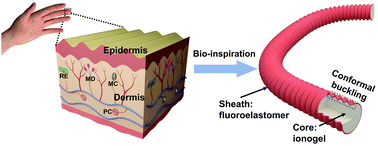Intrinsically stretchable sheath-core ionic sensory fibers with well-regulated conformal and reprogrammable buckling†
Abstract
Fiber-based intrinsically stretchable ionic conductors are appealing in the emerging imperceptible sensing devices with an ultrabroad working range, yet still suffer from a low strain sensitivity (gauge factor generally smaller than 3) as compared to electronic conductors. To circumvent this issue, here we report downsized superelastic sheath-core ionic sensory fibers with a fingerprint-like conformal buckling architecture. By delicately regulating the intermolecular interactions in the ionogel core and fluoroelastomer sheath as well as adjusting holding strains, the transparency and buckling density of the fiber are finely modulated. Heat to above 60 °C would further erase the formed buckles, enabling the encoded information of the fiber to be reprogrammable. Importantly, introducing conformal buckles are shown to bring about two-fold sensitivity enhancement of the sensory fibers, leading to a considerably high gauge factor of 10.1 for ionic strain sensors. Furthermore, the water droplet control ability of the buckled fibers with tunable wettability is also demonstrated, contributing to the versatility of the present sensory fibers which may gain promising applications in integrative electronics, optics, and microfluidics.



 Please wait while we load your content...
Please wait while we load your content...